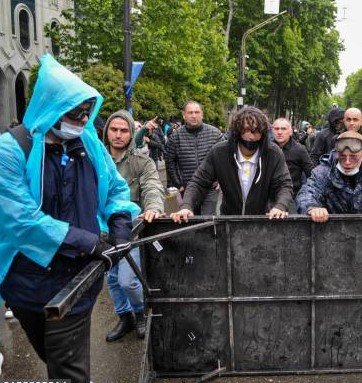In a dramatic and symbolic act of defiance, protesters in Tbilisi set fire to a coffin containing the name of Bidzina Ivanishvili, the influential Georgian billionaire and founder of the ruling Georgian Dream party. The protest took place on Rustaveli Avenue on the night of December 9, 2024, as demonstrators expressed their frustration with the perceived authoritarian grip of Ivanishvili and his political faction over Georgia’s government.
The procession began with the coffin being carried ceremoniously along Rustaveli Avenue, a key thoroughfare in Georgia’s capital. It was later placed in front of the Georgian parliament and set alight, with protesters chanting for Ivanishvili and his party to relinquish control. This fiery act was not just a performance but a powerful expression of public dissatisfaction and an appeal for change in the country’s political climate.
A Bold Message of Political Discontent
The protesters, many of whom have grown increasingly disillusioned with Georgian Dream’s leadership, view the symbolic burning of Ivanishvili’s name as a clear message. They want to see an end to what they describe as the party’s authoritarian tendencies and its influence over national affairs. The symbolic act highlights the deep anger felt by sections of the Georgian population, who believe that their voices are being drowned out by a concentrated power structure.

While some may have found the protest theatrical or even humorous, the symbolism was unmistakable. It represented not only discontent with one man’s political control but also broader dissatisfaction with the state of Georgian democracy. Protesters are demanding a shift towards greater political plurality and a move away from what they see as a stifling, centralized rule.
Tensions and Arrests Amid the Protest
Despite the dramatic nature of the protest, there was a notable absence of riot police, which has often been a characteristic response to large demonstrations in Tbilisi. However, that didn’t stop the authorities from taking action. Several individuals were arrested throughout the city by patrol police, though there was no major crackdown on the protest itself.
While there is no denying the strong emotions behind the protest, the lack of significant police intervention suggests a shifting dynamic between Georgia’s government and its opposition. Whether this signals a change in the country’s approach to protests or a sign of underlying tensions remains to be seen.
A Country at a Crossroads
The burning of “Ivanishvili” in a coffin is more than just an act of political theater; it is the latest in a series of protests aimed at addressing perceived political stagnation and frustration with Georgian Dream’s rule. With tensions between the government and the opposition escalating, and with a growing sense of disillusionment among many Georgians, the future of the country’s political landscape is uncertain.
